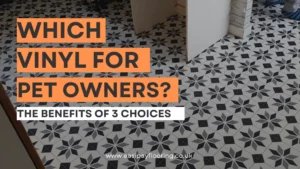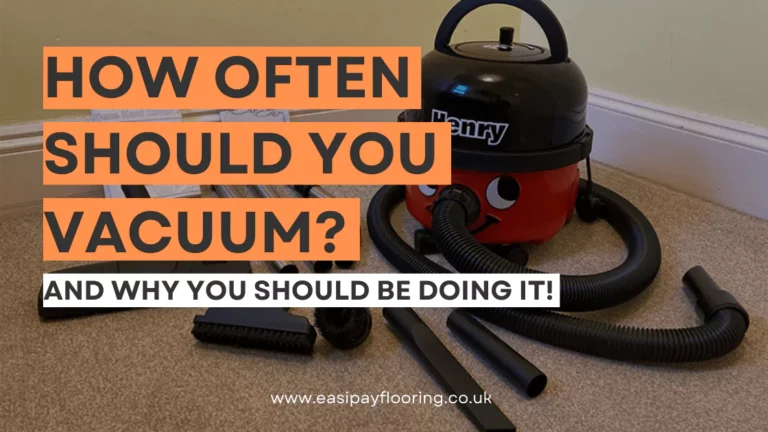
Please Note: We’re currently out of stock of LVT, while we switch supplier, we’ve reduced the cost of SPC flooring to the price of our LVT.

Get In Touch:
03303 332360


Regular vacuuming is a crucial aspect of maintaining a clean and healthy home environment. Carpets can harbour dust, allergens, pet dander, and various other particles that can affect your indoor air quality and overall health. Understanding how often to vacuum and the potential risks of not vacuuming enough can help you keep your home in top condition.
Carpets act as a filter in your home, trapping dust, soil, bacteria, and allergens. Regular vacuuming removes these particles from the carpet, preventing them from circulating back into the air. Here are key reasons why you should maintain a regular vacuuming schedule:
Dirt and grit embedded in carpet fibres can act like sandpaper, wearing down the fibres over time. Regular vacuuming extends the life of your carpet by preventing the build-up of these abrasive particles.
Carpets can trap allergens like pollen, pet dander, and dust mites. If not regularly vacuumed, these allergens can be kicked back into the air, reducing indoor air quality and potentially causing allergic reactions.
Regularly removing dirt and debris helps maintain the carpet’s appearance, contributes to a cleaner home environment, and can significantly improve the feeling of your living space.
The frequency of vacuuming can vary based on several factors including the number of people in the household, presence of pets, and general lifestyle:
Neglecting to vacuum regularly can lead to several problems:
Allergens trapped in carpets can lead to respiratory problems, allergic reactions, and exacerbate asthma symptoms, particularly in children and the elderly.
Moisture can easily get trapped in carpets and if not vacuumed and dried properly, it can lead to mould and mildew growth, which are harmful to health and difficult to eradicate.
Pro Tip – Remove smells associated with things like mould growth with Baking Soda!
Crumbs and food particles in carpets can attract pests like cockroaches and ants. Regular vacuuming helps prevent pest infestations by removing food sources.
You might be interested in: Do Carpet Cleaners Kill Flees?
The longer spills and stains remain in the carpet, the harder they are to remove. Regular vacuuming helps lift dry stains and debris before they set in.
Vacuuming is more than just a chore; it’s a vital part of maintaining a healthy living environment. Adjust your vacuuming frequency based on your household needs to ensure your carpets stay clean, extend their lifespan, and most importantly, keep your indoor environment healthy. Remember, the cleaner the carpet, the cleaner the air you breathe!
At Easipay Flooring we offer Carpets, Laminate, Vinyl, SPC and LVT flooring at affordable prices. You get free underlay with suitable flooring types and we even let you break down the cost into weekly, fortnightly or monthly payment plans too, completely interest free! Sound good? Tap the button below to get set up a home visit to see our samples and get your free quote!
An upright vacuum with adjustable height settings and a brush roll is generally best for carpets. It should have good suction power and HEPA filtration to capture fine particles effectively.
If your vacuum isn’t picking up debris as well as it used to, check for clogs in the hose, full bags or canisters, and worn belts or filters. Regular maintenance can help restore its efficiency.
While regular vacuuming is important, excessively vacuuming with a very powerful vacuum can potentially damage carpet fibres, especially if it’s a delicate type. Adjust the settings according to your carpet’s durability.
Yes, during seasons when allergens are high, like spring and fall, or in winter when more time is spent indoors, you might need to vacuum more frequently to manage the increased indoor pollutants and debris.
Vacuum high traffic areas slowly in multiple directions to ensure you pick up as much debris as possible. These areas may need multiple passes to clean effectively.
Besides visually inspecting, run your hand over the carpet after vacuuming. If you can feel or see dust and debris, it might need another pass.
Yes, long pile carpets often require you to use a vacuum cleaner without a rotating brush or with the ability to turn off the brush roll to prevent tangling and damage to the fibres.
Check your vacuum’s manual for specific recommendations; generally, filters should be cleaned or replaced every 3-6 months depending on usage.
If your vacuum leaves marks, it may be set too low. Adjust the height setting, so it doesn’t press too hard on the carpet. Also, ensure the wheels and brushes are clean and not damaged.
Regular vacuuming can help remove pet hair and dander that contribute to odours; however, for stronger odours, consider using a powdered carpet freshener or a steam clean for deeper deodorization.
Many modern robot vacuums are effective on carpets, especially for maintaining cleanliness between deeper cleans with a more powerful upright vacuum.
Vacuum bags should be disposed of in a sealed bag to prevent any captured dust and allergens from escaping. Canisters should be emptied into a trash can, ideally outdoors, to minimize the spread of dust indoors.
Signs include visible dirt and lint on the carpet, a dusty or stale smell in your home, and increased sneezing or allergies among household members.
Use doormats at all entrances and encourage or enforce a no-shoes policy indoors. Regularly clean these mats to prevent dirt transfer.
Consider professional deep cleaning annually or biannually, and spot treat stains as they occur. For households with pets or allergies, a regular schedule of steam cleaning can also be beneficial.
Contact Us!